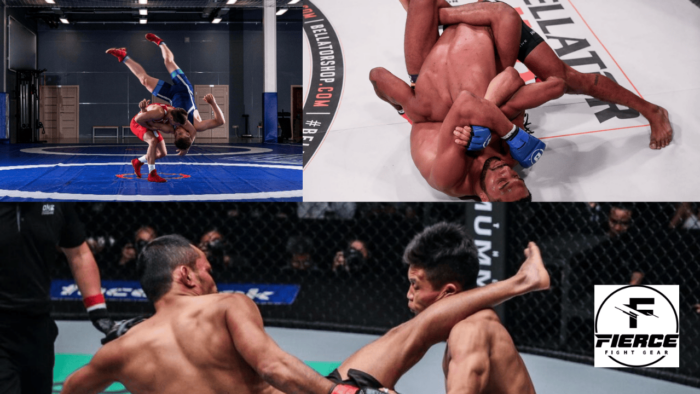Mixed Martial Arts (MMA) has taken the combat sports world by storm. It’s an electrifying sport that combines various fighting styles into one thrilling competition. But what is MMA fighting, and why has it captured the imagination of sports enthusiasts worldwide? In this guide, we’ll be answering this popular question, exploring its origins, rules, fighting styles, safety measures in place, and more.
What is MMA Fighting?
MMA, or Mixed Martial Arts, is a combat sport that blends different martial arts disciplines into a dynamic fighting style. Unlike traditional sports like boxing or karate, MMA fighters are not limited to a single form of combat. Instead, they incorporate striking techniques from disciplines like boxing, muay thai, and kickboxing, along with grappling and submission skills from Brazilian Jiu-Jitsu and wrestling. The result is a breathtaking approach to fighting that keeps fans on the edge of their
If MMA fighting is a combination of several martial arts, what are the rules of MMA Fighting? Let’s find out in the next section.

The Rules and Regulations
Now that we have answered the question “what is MMA fighting?”, let’s take a look at some of the rules and regulations that MMA fighters have to adhere to while playing the game.
Weight Classes
MMA fighters are grouped into specific weight classes to ensure fair competition. These classes range from the smallest, like Strawweight (up to 115 pounds for women) and Flyweight (up to 125 pounds for men), to the heaviest, such as Heavyweight (over 205 pounds for men) and Featherweight (up to 145 pounds for men). Fighters must make weight before the fight to ensure they are within their designated class.
Rounds and Rounds Breaks
MMA matches are organized into rounds, with each round typically lasting five minutes. Championship bouts may consist of five rounds throughout. Between rounds, there are short breaks allowing fighters to catch their breath and receive instructions from their corner. The division of fights into rounds adds strategy and pacing to the competition.
Victory Methods
In MMA, the ultimate goal is to win the fight, and there are various methods to achieve this. A fighter can secure victory through knockout (KO) by rendering the opponent unable to continue due to strikes or by forcing a submission through joint locks or chokeholds. Judges play a crucial role in decision victories, evaluating fighters’ performance in striking, grappling, aggression, and octagon control if the fight goes the distance. Technical knockout (TKO) is declared when the referee intervenes due to a fighter’s inability to defend themselves.
Safety Regulations
While MMA is an intense sport, safety is paramount. Strict rules are in place to prevent dangerous moves such as eye gouging, strikes to the back of the head, hair pulling, or hitting the groin area. These regulations are essential for the fighters’ well-being and to uphold the sport’s integrity.
Understanding these rules and regulations is fundamental for any aspiring MMA fighter. They form the foundation of a fighter’s journey into the thrilling world of mixed martial arts, ensuring fair competition and fighter safety.
Fighting Styles in MMA
MMA fighters are like modern-day warriors, trained in a diverse array of martial arts. They excel in striking, grappling, and submission techniques, which together create the dynamic and multifaceted world of mixed martial arts. Some of these fighting styles are:
Striking
Striking is a fundamental component of MMA, involving various techniques like punches, kicks, elbows, and knees. Fighters in the striking aspect of MMA aim to deliver precise and powerful blows to their opponents, often with the goal of achieving a knockout (KO). The striking game requires exceptional speed, timing, and accuracy, making it a captivating aspect of MMA.
Grappling
Grappling is the art of takedowns, throws, and ground control. MMA fighters with a strong grappling background can dictate the pace of a fight by taking it to the ground and utilizing their skills to maintain control. Ground and pound, where fighters strike their grounded opponent, is a common strategy in MMA grappling.
Submissions
Submissions are a crucial part of MMA, involving joint locks and chokeholds. The objective is to manipulate the opponent’s joints or restrict their airflow, forcing them to submit. Skilled submission artists can turn the tide of a fight even when they seem to be at a disadvantage, adding an element of suspense to every match.
These versatile fighting styles create an unpredictable and exciting spectacle in the MMA world. Fighters often train in multiple disciplines to become well-rounded and adaptable, making each matchup a unique and thrilling experience for fans and competitors alike.

Notable MMA Organizations
Two major MMA organizations have played a significant role in popularizing the sport: the Ultimate Fighting Championship (UFC) and Bellator. The UFC, in particular, has become synonymous with MMA and boasts a roster of world-class fighters. These organizations have helped MMA gain recognition on a global scale, organizing events featuring top fighters from around the world.
Fight Gear, Wear, and Accessories Needed for Muay Thai
Muay Thai is a dynamic and physically demanding combat sport that requires the right gear to ensure safety and enhance performance. Whether you’re a beginner or an experienced practitioner, having the appropriate Muay Thai gear is essential for training and competing. Here’s a breakdown of the gear, wear, and accessories you need:
- Muay Thai Gloves: Proper Muay Thai gloves are crucial for hand protection during training and sparring. They offer padding for both your hands and your training partner.
- Hand Wraps: Hand wraps provide extra wrist support and protection for your knuckles. They help prevent injuries like sprains and fractures.
- Shin Guards: Shin guards are essential to protect your shins and lower legs during sparring sessions. They also offer protection to your training partners.
- Mouthguard: A mouthguard safeguards your teeth and jaw from impacts during training or sparring. It’s a vital piece of protective gear.
- Groin Guard: For male fighters, a groin guard is essential for protection during sparring and fights.
- Ankle Supports: Ankle supports or braces provide stability and reduce the risk of ankle injuries, which can be common in Muay Thai due to footwork and pivoting.
- Muay Thai Shorts: Muay Thai shorts are specially designed for comfort and freedom of movement. They typically have wide legs and an elastic waistband.
- Rash Guard: A rash guard is worn under your shorts or pants. It helps keep you dry and prevents skin irritation during training.
- Headgear: While not always required, headgear can be beneficial for extra protection during sparring sessions, especially for beginners.
- Training Pads: Focus mitts, Thai pads, and heavy bags are essential for training. They allow you to practice strikes and combinations with a partner or on your own.
- Muay Thai Shoes: Muay Thai-specific shoes offer better grip and support for the unique footwork and movements involved in the sport.
- Sweat-Wicking Clothing: Moisture-wicking clothing keeps you dry during intense training sessions by wicking sweat away from your skin.
- Water Bottle: Staying hydrated is crucial during training. A reusable water bottle is a must-have for any Muay Thai practitioner.
- Gym Bag: A spacious gym bag helps you carry all your gear and accessories to and from training sessions.
- Joint Supports: Elbow and knee supports can be beneficial for preventing injuries and providing extra support, especially if you have previous joint issues.
Investing in high-quality Muay Thai gear with Fierce Fight Gear ensures your safety, comfort, and optimal performance during training and fights. Whether you’re a recreational enthusiast or aspiring to compete professionally, having the right gear is essential for your Muay Thai journey.
What is MMA Fighting? Are there safety measures in place for fighters?
Yes, there are indeed safety measures in place for fighters. Safety is paramount in MMA, and strict regulations are in place to protect fighters from serious injuries. These measures ensure that while MMA is a physically demanding and intense sport, it is also a controlled and relatively safe competition. These are some of the safety measures that are put in place for fighters:
Medical Examinations
Before every fight, fighters undergo comprehensive medical examinations. These include physicals, blood tests, and neurological assessments to confirm their fitness to compete. Any underlying medical conditions or injuries are carefully assessed to prevent unnecessary risks.
Weight Classes
MMA fighters compete in specific weight classes to ensure that they face opponents of similar size and strength. This minimizes the risk of extreme weight cutting, which can be dangerous. Fighters must weigh in before the fight, and if they exceed their designated weight class, they may be disqualified or face other penalties.
Referee Intervention
During fights, experienced referees monitor the action closely. Their primary responsibility is the safety of the fighters. Referees can step in to stop a fight if they believe one of the competitors is unable to defend themselves or if they witness any rule violations that could lead to injuries.
Corner Teams and Medical Personnel
Each fighter has a corner team, including coaches and cutmen. These individuals play a vital role in ensuring the fighter’s safety during and between rounds. Cutmen handle any cuts or injuries to prevent excessive bleeding. Medical personnel are also present at ringside to provide immediate medical attention if needed.
Fouls and Penalties
MMA has a strict set of rules and regulations, and violations can result in point deductions or disqualification. Fighters are prohibited from using certain techniques that could cause significant harm, such as eye gouging, strikes to the back of the head, or strikes to the groin. These rules exist to protect the fighters from unnecessary harm.
Post-Fight Medical Checks
After a fight, both winners and losers are subject to post-fight medical checks. This ensures that any injuries sustained during the bout are promptly identified and treated. Fighters are often required to take time off to recover if necessary.
Safety measures in MMA are comprehensive and stringent, designed to protect the fighters and maintain the integrity of the sport. While MMA is undoubtedly a physically demanding endeavor, these measures help ensure that fighters can compete at the highest level with confidence in their well-being.
That’s a brief introduction that answers the question “What is MMA Fighting ” and gives a summary of what you need to know to get started with the sport. Remember to stay hydrated with a reliable water bottle and carry your gear in a spacious gym bag. Whether you’re training for fitness, self-defense, or competition, investing in the right muay Thai gear with Fierce Fight Gear products ensures you’re well-prepared for this exhilarating martial art. So, gear up, train hard, and embrace the Muay Thai experience with confidence!
